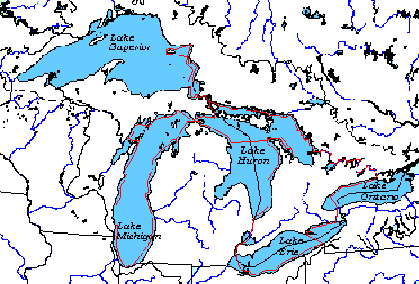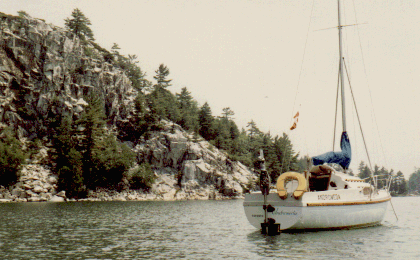- Introduction
- Planning
- planning
- departure
- Canals
- Lake Ontario
- Lake Huron
- Lake Superior
- Lake Erie
- Epilogue

The route I planned is shown in red on the map

Pandora anchored in the beautiful Baie Finn near Killarney in Georgian Bay
The route I planned is shown in red on the map, starting from Toronto (NW point on Lake Ontario) going NE.
Making the decision to go on a trip like this is often the most difficult part of a trip. For me though, it was easy. I could get a four month unpaid leave of absence from work and I was highly motivated and felt I had enough experience and the right boat to do it. No long offshore passages were required so I did not see it as being that dangerous or difficult.
I quit renting my apartment, threw out most of my belongings (didn't have much anyway) and left my valuables with my girlfriend (she joined me whenever she could).
I spent two years researching every aspect of the trip. Charts and cruising guides were going to be the biggest problem as I needed detailed charts for major parts of the coastlines of all the lakes - they would actually take up a considerable volume in the boat. I folded them such that they would fit on my small navigation table. They were also the major expense of the trip. No GPS or digital maps in the late 70's.
The only controversial part of the trip was the plan to do part of Lake Superior. Other sailors thought I was a little crazy to even contemplate sailing Superior, especially in such a small boat.
I found out that there was only a two to four week window to sail on Lake Superior when the fog and average wave heights were a reasonable minimum. The rest of the trip was planned around this requirement. Cruising is always about maximizing having the odds in your favour.
I had cruised the boat extensively for a number of years and felt it was as good as it could be. The main could be single or double reefed very quickly in a simple way having four cleats on the end of the boom for the foot and tack. I had a good storm jib. There was a downhaul on the jib and also twin jib poles, with one jib set up with a wire luff so it could be set without hanks when running downwind with two jibs. The Hydrovane self-steering worked great on this boat, even running with the twin jibs, and I had total faith in its reliability as it was designed for boats 10 times the weight of mine. The Honda four stroke was quiet, plenty of power, and very economical. The boat had no through-hulls, basically no electronics other than a depth sounder. I had a kerosene anchor light and navigation lights could be run off the battery but I never planned to use them. I am a great believer in self-sufficiency and carried no VHF (they were expensive back then), just a portable weather receiver. I had two heavy anchors with all chain rode (on a small boat 1/4" chain is not that heavy - I had 500' of chain).
The boat was completely bug proof - essential when sailing the Great Lakes (only a problem at dusk). I carried just the essentials, a good tool kit, binoculars, sail repair material, a good dinghy, navigation equipment including a custom navigation station I made in the boat. I had also purchased an electric autopilot for the canals. I had also rigged a way of hoisting the mast up or down by myself using the jib winch and my twin jib poles which was very quick and easy as some canals required the mast down.